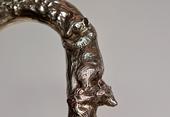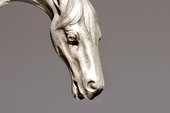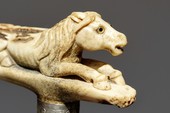The term Cloisonné comes from the French “cloison” which translates to mean “partition”. It is the process by which different colours of enamel are, as the name suggests, separated by partitions made of thin metal ribbons, no thicker than a strand of hair, and fused onto a base layer of enamel to form intricate designs. This can be done by hand, or by using tweezers. Once in place the partitions, then filled with layers of enamel, until level with the top of the ribbons. The metal remains visible, allowing the beautiful patterns to shine through.
Cloisonné is widely considered to be the first enamelling method to come into existence and the ancient Mediterranean cultures have witnessed these beautiful crafts since the 10th century BC. * Anordain enamelling techniques.
This cane is fashioned as an elongated Milord shape and modelled in the enamel cloisonné technique with Japanese patterns, it is coloured with Bordeaux-red, yellow, stardust-composite, white, and pistachio green, where butterflies and cherry blossoms are the predominant motifs. The elaboration detail and fineness suggest high skills. It is 15 cm high x 4 cm diameter on top of a slender ebonized shaft, carved imitating dots, and finishing with a bimetal ferrule, the O.L. is 91 cm, there are minimal signs of use, and the condition is perfect.
Antique Walking Cane Collection Antiker Spazierstock Sammlung Antique Canne Collection Antiek Wandelstok Verzameling Antico Bastone Collezione Античный трость коллекции Baston Antiguo Coleccion
















